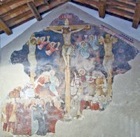

San Pietro (12th century)
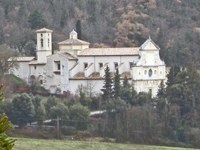
This church is built into the lower slopes of Monteluco next to the site of a pre-Roman necropolis. The necropolis was later used as a Christian cemetery, as is evidenced by a number of sarcophagi (6th century) found on the site. A number of these are now in the Museo del Ducato di Spoleto (see below).
First Church
The circumstances in which the first church was built here in the 5th century are known from three original inscriptions. These no longer exist, but their content is known from copies (9th or 10th century) from the Abbey of Lorsch that are now in the Vatican Archives.
-
✴The first inscription is in the form of a Latin poem of 32 lines on two separate tablets. It begins: “Achilleus, devoted bishop of Christ built a large edifice in honour of St Peter”. This must have been Bishop Achilleus, who was documented in 419. Carlo Carletti (see below) has summarised the theme of the remainder of the poem as “Magna Roma - Magna Petrus”, and pointed out that it drew heavily upon letters (422) in which Pope Boniface I set out the dogma of the Petrine succession.
-
✴The second, a poem of only four lines, refers to the prerogative of St Peter to melt the chains of evil.
-
✴The third seems to have been written after the death of Bishop Achilleus. It recorded that he had built this church on the mountain above the road to Rome, that he had dedicated it to St Peter and that it contained a relic from the chains of St Peter. This is the earliest surviving reference to this relic: it is generally assumed that Bishop Achilleus acquired filings from the chain when he was in Rome in 419.
San Pietro seems to have been used for the burial of Bishop Achilles and his successors.
-
✴An inscription [CIL XI 4972] that was found under the pavement of the apse in 1650 (but subsequently lost) belonged to Bishop Amasius, who died in 489 (the year of the Consul Petronius Probinus) aged 85, after having been bishop for 13 years. Two sarcophagi that were found at the same time were re-discovered in 1952 and are now under the high altar (see below).
-
✴The monk John, who wrote the legend of St John of Spoleto (see below) in the reign of the Emperor Otto II (967-83), referred to the epitaph of Bishop Petrus (Peter) in the church. According to local historians, he was bishop in the period 563-93. If this is correct, he would have been the bishop who refused to provide church for an Arian bishop after the Lombard invasion, causing him to attempt to take San Paolo inter Vineas by force.
An architrave that seems to have formed part of the portico of the early church was discovered in the 1960s. It contains an inscription (5th century) that refers to a construction project that was undertaken with the help of God. It was later embedded in the wall of the adjacent church of San Silvestro and is now in Room 2 of the Museo del Ducato di Spoleto (see below).
San Pietro in Hagiographic Legend
-
✴A version of the legend of St Laurence (BHL 4748d) places him among a large of Syrian immigrants who came to Italy in 283. He succeeded an unnamed Bishop of Spoleto (perhaps St Brictius) who built San Pietro and had been buried here with an epitaph that identified his tomb.
-
✴According to most versions of the Legend of the Twelve Syrians, St John, whom St Brictius had ordained as Bishop of Spoleto in ca. 360 built the church of San Pietro. However, in the version devoted to St Herculanus (another of the twelve) St John merely decorated the church and built a staircase there.
Silvestro Nessi (see below) has suggested that the information regarding the predecessor of St Laurence had probably been taken from the epitaph of Bishop Achilles, whose name must have been illegible at that time. If this is so, Achilleus, Laurence and John could have been successive Bishops of Spoleto.
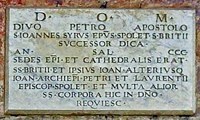
Present Church
A college of canons existed at San Pietro by 1128. It seems that Bishop Enrico Gualfriedi translated the relics of St John of Spoleto from Sant’ Eufemia to San Pietro in 1130. The canons presumably built the present church, which seems to date to the 12th or early 13th century.
The Ghibelline faction in Spoleto burned it down in 1329, although its splendid facade survived. The subsequent work of restoration was protracted: Pope Boniface IX offered indulgences for the reconstruction in 1393 but work was still in progress in 1404.
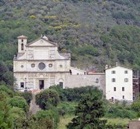
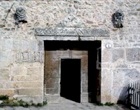
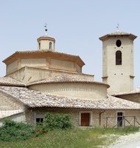
Interior
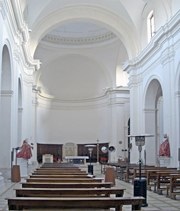
The church has a nave and lower side aisles, with an octagonal dome over the crossing. The interior was re-modelled in 1699.
[Two ancient sarcophagi under the high altar were discovered under the pavement of the apse in 1650 and re-discovered in 1952].
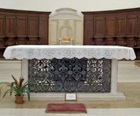
Madonna and Child with saints (14th century)
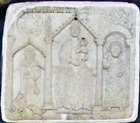
Font (1487)
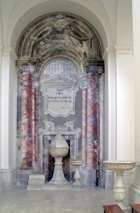
Water stoups (15th century)
These two water stoups stand by the first pilasters in the nave.
Tabernacle (15th century)
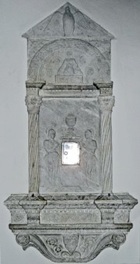
Finds from the Church
The following finds from San Pietro are now in the Museo del Ducato di Spoleto:
Terracotta Sarcophagus (6th century)
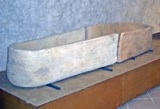
Architraves (mid 5th century)
These two architraves are in Room 2:


Relief (8th century)
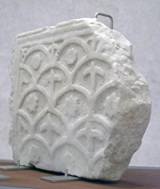
San Silvestro (14th century)
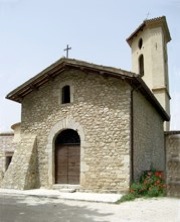
This tiny church was restored in 1963.
Crucifixion (15th century)
